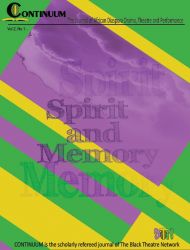Dutchman by Amiri Baraka
Directed by Woodie King Jr.
Castillo Theatre, New York City
1 March 2015
This April, I watched history repeat itself. Forty-seven years after Dr. King’s assassination, Baltimore burned once again. The reason hadn’t changed; the fires were fueled by a rather predictable occurrence in relation to the U.S. racial climate: a Black person (Freddie Gray) was allegedly killed at the hands of White racists. Amiri Baraka tapped into such danger throughout his 1964 drama, Dutchman, and, though I think we can agree that progress has been made over the past years, it is impossible to address a production of Baraka’s work without acknowledging its modern-day significance. No one knows this better than Woodie King Jr., founder of New York’s New Federal Theatre (NFT). King’s recent NFT production of Baraka’s Dutchman, performed at the Castillo Theatre in New York City between February 5 and March 8, 2015, echoed the unrest we’re witnessing on our nightly news stations, and recalled Dutchman as a springboard able to provoke audiences through its dramatic representation of a proposed retaliation.
Though Dutchman first premiered in March of 1964 for Cherry Lane Theatre, King’s production more accurately aligns itself with the 1965 performances produced by Baraka’s own Black Arts Repertory Theatre/School (BARTS) in Harlem. By excluding Whites from performing in their events, the system of segregation established by the BARTS mirrored the practices of traditional White theatre, and, indeed, society at large. For Castillo, King followed suit, employing an all-Black cast to reenact the horror story Baraka penned over fifty years ago.
The story in question pits a twenty-year-old Black man (Clay) against a thirty-year-old White woman (Lula) in a New York subway in the 1960s. Lula is predatory from the start, but as both sexual and racial tensions rise, the play grows even darker. Lula continually attacks Clay’s ethnicity, calling him a “liver-lipped white man” and an “Uncle Tom,” until he eventually erupts in rage. Clay’s verbal rant is lengthy and loaded, and does not go unpunished; when he has finished, Lula stabs him to death.
The play is said to be influenced by the myth of “the Flying Dutchman,” and, at first glance, King’s stage choices fit this allegory. In fact, before the action of the play begins, within the windows of set designer Chris Cumberbatch’s staged subway, which juts out towards the audience in a sharp “V,” King projects Baraka’s stage directions: “In the flying underbelly of the city. Steaming hot, and summer on top, outside. Underground. The subway heaped in modern myth.” In so doing, King further links the subway to the doomed ship, cursed to sail the seas forever.
Nevertheless, in King’s production, Ryan Jillian Kilpatrick’s Lula, in a blonde wig and white, pointy-nosed Venetian mask, is the oppressive force; it is her actions towards Michael Alcide’s Clay, along with the suggestion that she will repeatedly kill again, that more accurately aligns itself with the curse of “the Flying Dutchman.” Certainly, Kilpatrick enters the subway car masticating an apple, and later tempts Alcide with this universally accepted biblical symbol of evil and the loss of innocence. Alongside this biblical allusion, Kilpatrick’s performance draws upon the many myths and legends regarding seductresses; images of the Greek Sirens from Homer’s Odyssey come to mind. Essentially, Kilpatrick’s Lula stems from a long tradition of the femme fatale; indeed, her name resembles the name of Frank Wedekind’s protagonist from Earth Spirit (1895), Lulu. There is a distinct problem here, however.
If Lula’s repetitive acts of seduction and murder, reminiscent of Homer and Wedekind, are meant to connect back to the title via the legend of the cursed “Flying Dutchman,” by faithfully depicting so many links to White literary traditions, King and his cast potentially eclipse Dutchman’s powerful Black influence and risk criticism for assimilating into the mainstream media the play seeks to subvert. However, Baraka knowingly emphasizes these White literary traditions—those messages from the owners—to recall the history of slavery and the oppressive conditions it set forth. By adhering to Baraka’s intentions, King makes sure that his production’s main stakes remain defined by a Black American revolutionary theatre; carefully crafted associations to American slave history serve as a dominant influence over the Castillo production.
King makes clear connections to a slavery of the past through Bill Toles’s harrowing projections before the start of the play. Two projection screens flanked the stage as scrims covering the subway car windows revealed unsettling images of bound slaves and The Middle Passage. Here, King draws his audience’s attention to an altogether different allegory for Baraka’s title. In 1619, the Dutch, carrying twenty or so Africans taken from a Spanish ship, sailed (in a Dutch man-of-war ship) into the American Virginia Colony of Jamestown, exchanged the Africans for food and initiated slavery. In contrast to the White literary myths and legends, King’s direction of Dutchman, then, also recalls a historical moment that brought Africans to America and began a harrowing system of oppression for Blacks. Put another way, by linking the slavery of the past to the abhorrent conditions of race relations still present today, King is able to conjure a collective memory to make a move towards encouraging “Black” unity. While the title is clearly open to multiple interpretations, and Baraka was fully aware of both the White and Black resonances present within his play, King’s production is undoubtedly making a statement in response to the U.S. racial climate.
This explanation sheds light on Alcide’s portrayal of Clay, a young man in suit and tie who as a college student had aspired to be Baudelaire. Clearly, in the beginning, Clay attempts to assimilate with White culture, but it is this cultural assimilation that makes his character a symbolic corpse who has sacrificed himself in his attempt to connect with White society. In Alcide’s capable hands, Clay’s murder is not a consequence of his rant; rather, it is his inaction that ultimately gets him killed. Alcide’s Clay all but deflates after spouting his revolutionary rhetoric. This failure to act on his impulse, and preemptively defend himself against Lula’s ensuing attack, leaves him as another Black victim to be disregarded by the U.S. legal system.
In the world of King’s Dutchman, Clay gets it wrong, and his miscalculation and reluctance leave him vulnerable; a system of defense is exactly what is needed to combat Kilpatrick’s Lula. Clay’s explosive Black rage and threats to kill in response to the bigotry he faces serve as examples of Baraka’s concept of a revolutionary theatre. Through his recent production, King clearly draws upon his relationship to (and with) both Baraka and the Black Arts Movement of the 1960s, and reestablishes Clay’s words as a necessary action.
Within the extreme Black struggle of the 1960s, how else should one have felt in the face of illegal forced segregation; overlooked or ignored lynchings; brutal and bloody beatings at the hands of corrupt law enforcement while peacefully protesting for Civil Rights; sanctioned White supremacist groups such as the Ku Klux Klan, who would often murder Black people to keep them from registering to vote; and an overall oppressive and repressive White, racist bigotry? But, King seems to ask, have we really come so far?
Douglas S. Kern
University of Maryland, College Park



